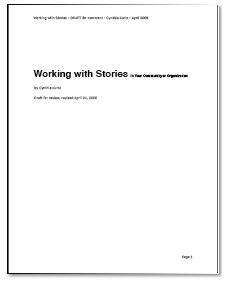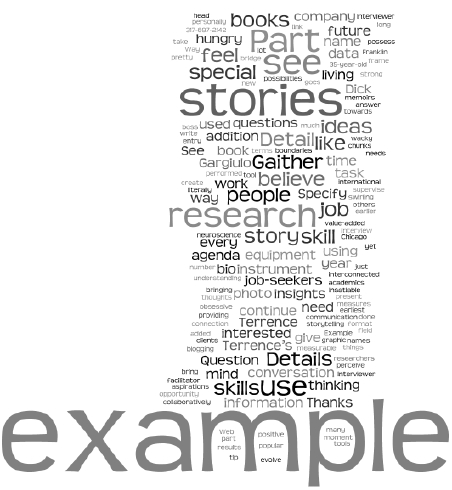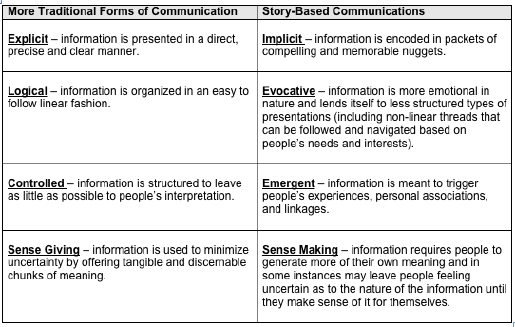It never ceases to amaze me that I continue to come across story-related resources that I didn’t know about before. The discoveries multiply exponentially as one site or blog leads to another. As a blogger about the world of storytelling, I am confident that I will never run out of material.
Here are four recent discoveries:
I love this ad for PNN (Personal News Network), which is described by founder Lauren Elliott as “a place for stories.” 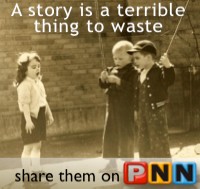 Elliott goes on to say:
Elliott goes on to say:
It’s a place to read stories and a place to add your own. We all have great stories in us. Some funny, some tragic, some sad, some happy, some boring, some just rants. But the thing is, we all have them, and they should be shared, in fact they must be shared.
Mainstream media is pretty much all the same stuff. Important stuff at times, but pretty much all the same. The trouble is you can’t read really good stories. You know, the really important ones about life and love and struggles and such? Stories told by people that you can relate to, normal, struggling every day sort of people you can trust. And in mainstream, you can’t form a relationship with the authors — or chat with other people about the same thing. Well, we hope that PNN becomes a place that you can do all these things.
Major story categories on PNN seem to be A&E (arts and entertainment?), Family, Living, Diversions, Politics, Green, Glitz, World, Sports, Paws, and Education.
I discovered PNN through About-Personal-Growth.com. Major categories here include: Relationships, Communication, Leadership, Success, Life, Self Esteem, Motivation, Emotion, and Mind. There is, of course, also a Stories section, described this way:
Reading stories is one of the ways for you to understand life. On the following pages, you will find personal growth stories to let you see that good and bad things happen to everyone. The aim of telling you the stories is to get you involved when you read them. From reading them, you might get a better understanding about life. Hopefully, the personal growth stories here will help you gain insights and inspiration. You may realize that you have your own collection of stories that have taught you valuable lessons and make you the person you are today.

Next up is The Experience Project, described as “the first Social Experience Website, where you can anonymously share and connect around the ideas and experiences that matter the most to you. This is a place where who you are — what you think and feel — is more important than who you know or what you look like.” While stories are not the only feature of The Experience Project, they are a significant part (the graphic below shows some of the topics) :
Join thousands of members sharing stories about their life experiences. Read another’s perspective on something you’ve experienced, or discover something entirely new. Then, start sharing your own thoughts to connect with people that understand you. Stories and personal experiences are shared within Experience Groups filled with people that understand your situtation and can provide support and meaningful friendship. By sharing, you will grow your network of new friends, help people facing the same situation, and feel better, since writing is therapeutic!

Finally, stories on a singularly serious topic at Telling Our Stories. Here’s the background:

High school students at the Urban School of San Francisco conduct and film interviews with Bay Area Holocaust survivors in their homes. Students then transcribe each 2-plus hour interview, create hundreds of movie files associated with each transcript, and then post the full-text, full-video interviews on this public website as a service to a world-wide audience interested in Holocaust studies. … This is an ongoing, ever-changing, and constantly evolving project involving dozens of students, teachers, and community volunteers.
The site includes more than 30 hours of interviews with eight Jewish survivors and refugees, stories of WWII Camp Liberators/Witnesses — eight U.S. soldiers deployed in Europe who witnessed Nazi concentration camps, and stories of 11 Japanese Americans deported to internment camps during WWII.
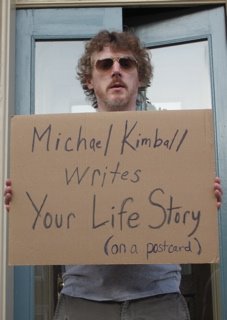 I have to admit I don’t completely understand what’s going on with Michael Kimball, his art project, Michael Kimball Writes Your Life Story (on a postcard), and his blog, also titled Michael Kimball Writes Your Life Story (on a postcard). For example, Kimball captions the photo seen here “The Cardboard Sign That Started It All.” How so? I want to know the story behind his project of writing people’s life stories on postcards. In the meantime, here’s his process:
I have to admit I don’t completely understand what’s going on with Michael Kimball, his art project, Michael Kimball Writes Your Life Story (on a postcard), and his blog, also titled Michael Kimball Writes Your Life Story (on a postcard). For example, Kimball captions the photo seen here “The Cardboard Sign That Started It All.” How so? I want to know the story behind his project of writing people’s life stories on postcards. In the meantime, here’s his process:
